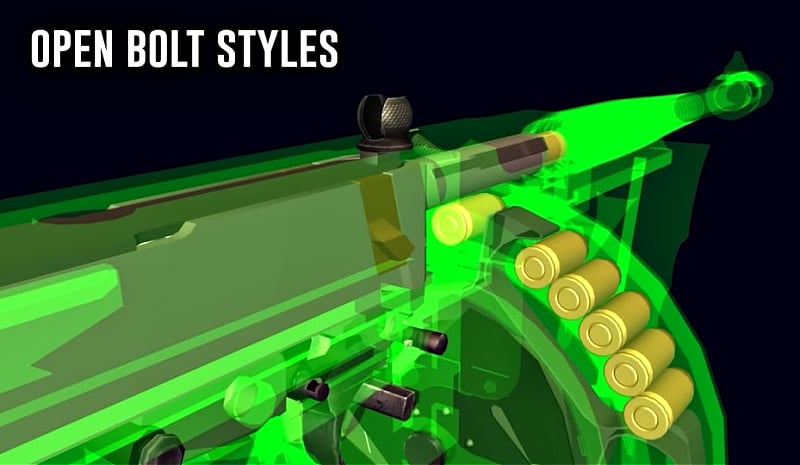The Thompson Submachine Gun traces its origins back to Brigadier General John T. Thompson, who was born in 1860 and graduated from West Point. Thompson was involved with the testing and adoption of US Army Weapons and even helped to choose the .45 caliber ACP as the Army’s official handgun cartridge. He wanted something more simple than the BAR, which is why he eventually settled on the Blowback Blish System that the Tommy Gun uses.
Thompson discovered that the Blowback System could not handle rifle cartridges because that much energy was too abusive to the bolt. The blowback system would only work with a less powerful pistol caliber. Engineers informed Thompson that the rifle caliber would not work and that they were instead using the .45, and he stated, “Very well. We shall put aside the rifle for now and instead build a little machine gun. A one-man, hand-held machine gun. A Trench broom.” Since the .45 ACP was the pistol caliber on the menu, it was a no-brainer. The time frame that this took place was during WWI.

The Thompson SMG was more portable and maneuverable than the BAR, and easier to control during firing. Thompson gave the option of a 30-round stick magazine or a 50-round drum magazine for feeding. Drum magazines weren’t widely used in the field because they were cumbersome and rattled, and they had to be wound nine times to produce spring tension before being used. The 30-round magazines were more practical.


World War I ended a few days before the new prototype SMGs could be shipped to Europe to be used in the field. It couldn’t be called a “machine gun” because it used a pistol caliber. It was referred to as a “Little Machine Gun”, but that term didn’t quite fit either. It was in 1919 that the term “submachine gun” was finally coined. It’s debatable whether or not the Thompson SMG was the first SMG ever built, as that distinction might go to the German MP-18.
In WWII, over one million Thompson SMGs were sold to the British and American armies. Troops generally liked it, but as troops are prone to do, they also had some gripes. Specifically, that it was not very accurate past 50 yards, and it was heavy.

When used with a 50-round drum, the early, light barrels of the Thompson would heat up very quickly. NCOs, such as sergeants, were often armed with the Thompson. Armored vehicle crews frequently carried the Thompson because it was compact and fit well in the confined spaces of their tanks. Commandos and Rangers often used it during raids when they needed close-in firepower.
The Thompson, or “Tommy Gun” had a rate of fire of 650 rounds per minute and a muzzle velocity of 285 meters per second, according to the video. Weighing in at 11 pounds, the gun soaks up much of the recoil, which Cappy says was about on par with a 9mm.

Other firearms from that era are still soldiering on. For example, the 1911 is still produced today, as is the M2 Browning .50 caliber Heavy Machine Gun. Even the M-1 Garand is kind of still with us in the form of the M-14/M-1A, which is still in use with some units of the military currently.
So why didn’t the Tommy Gun live on, well into the 21st century?
The Thompson cost approximately $3,000 to make in today’s money, which was certainly not an advantage during WWII. The Tommy Gun was made from milled parts, which are basically carved out of chunks of metal, which is the reason it was not only heavy but also expensive to manufacture. In addition to the cost of manufacture, it was also complex to build, which made it more time-consuming.
As Cappy points out in a recent Task & Purpose [YouTube channel] video above, the Thompson was/is an iconic firearm, but was discontinued by the US Military. Cost, weight, and possibly the perception that it was a “gangster weapon” from the Prohibition Era were likely reasons for it being discontinued. Although it was definitely used by some organized crime figures in the 1920’s, the Tommy Gun likely wasn’t used as extensively as the movies might have us believe. Nevertheless, once a stigma is attached to any object, it is difficult to shed.


The M3 submachine gun (nicknamed the “Grease Gun” because of its appearance) spelled the end of manufacturing for the Thompson SMG. The Grease Gun widely used metal stampings, and was quick and easy to produce, and literally cost just a few dollars to make. Kahr Arms did release a “tactical”, Picatinny version in 2018, but it’s not being used by any agencies or units that I’m aware of.

Interestingly, the prison where I used to work had Thompson SMGs in its armory at one time. I actually saw a 50-round drum from a Tommy Gun back in the day, but the Thompsons had been long gone (sadly) by the time I started my career in 1990. Make no mistake, I’d have been thrilled to qualify with one on the range had I been offered the opportunity! Over the decades, many other law enforcement agencies had also employed the Thompson in their inventories.
No, the Thompson won’t be back in military service again, which is sad. The old soldier served admirably and then was ditched by the military. It did go on to serve in Korea, and even saw some use in Vietnam, though it was not general issue with US troops, it served with some ARVN units. Nowadays, they are prized by collectors. That said, when anyone mentions submachine guns, it’s not unusual for them to picture the Thompson SMG in their mind, and it’s iconically used in media as well.


